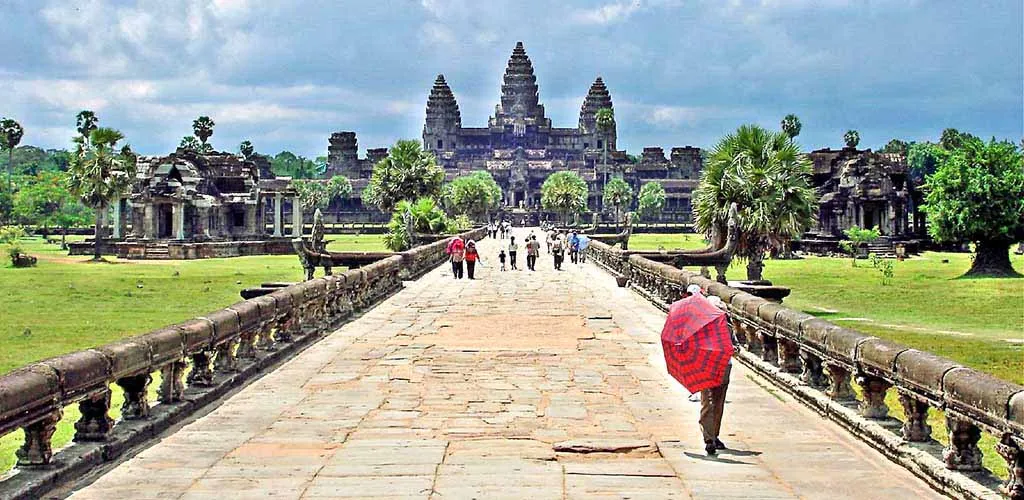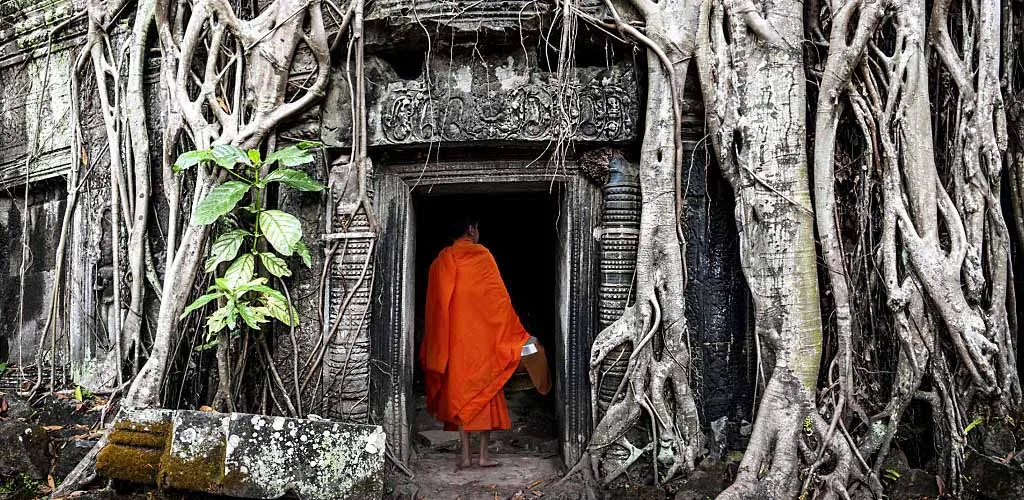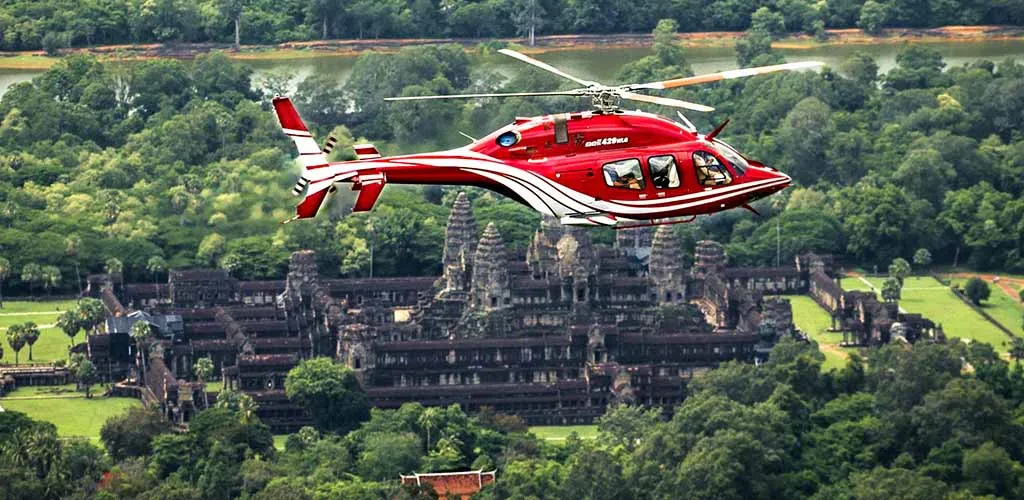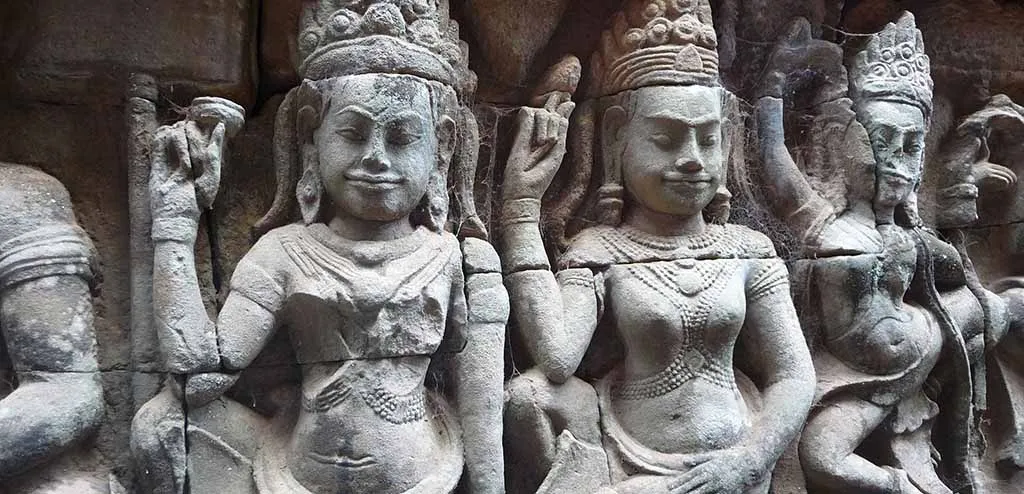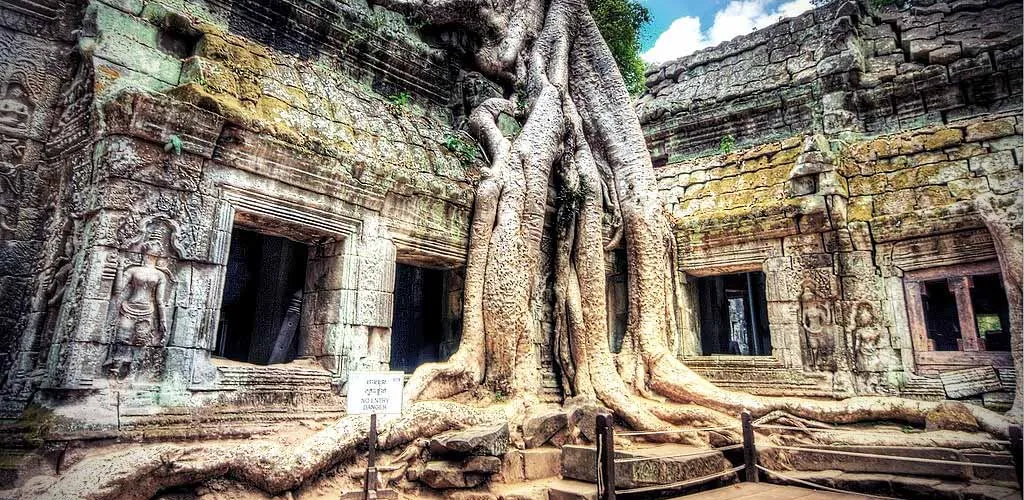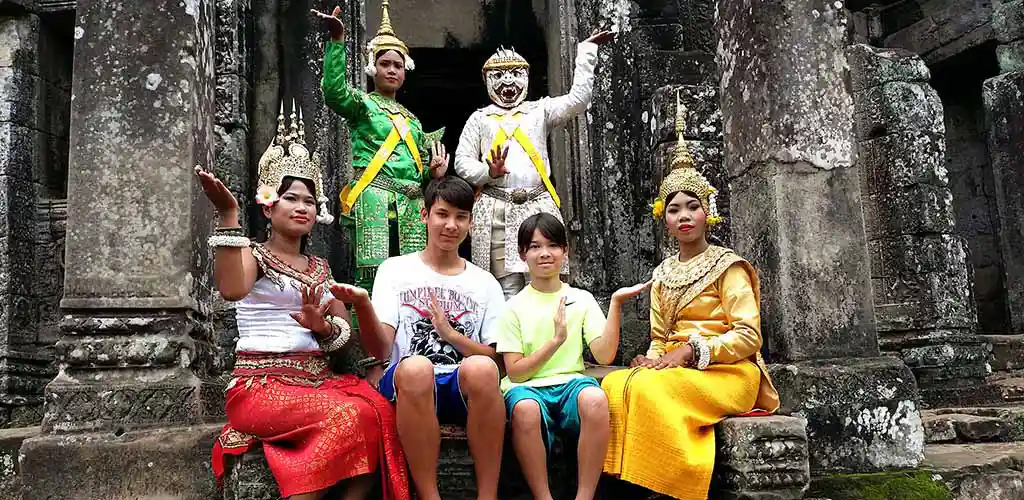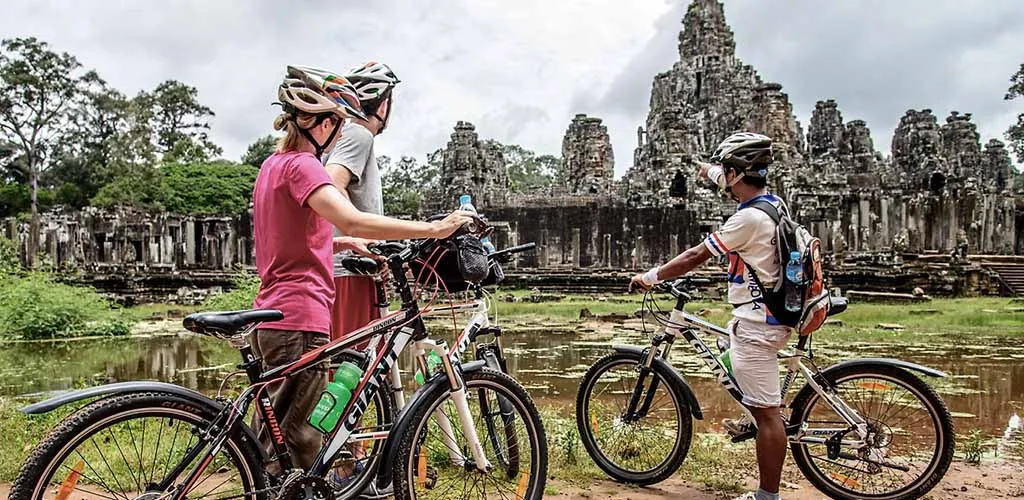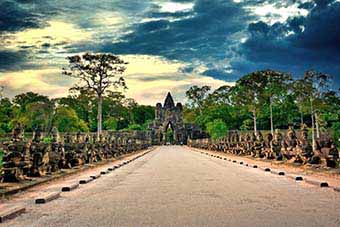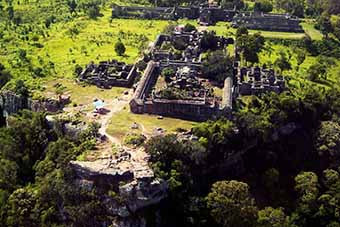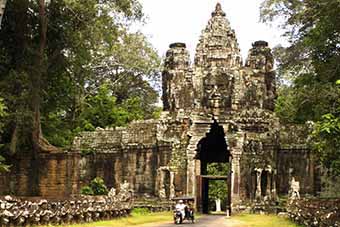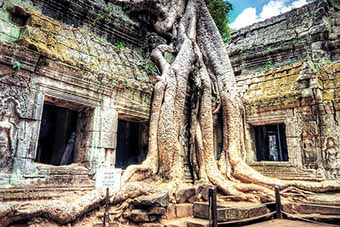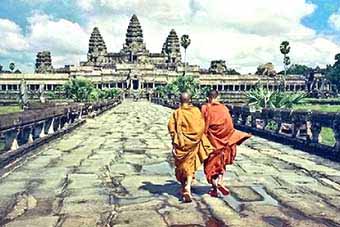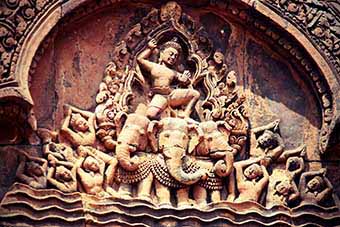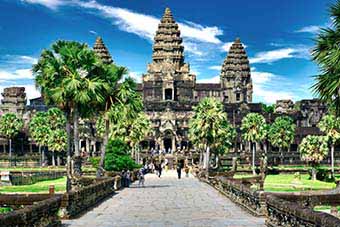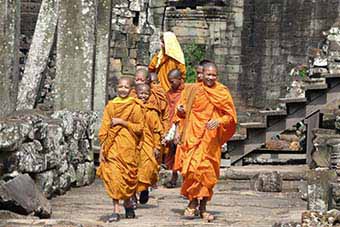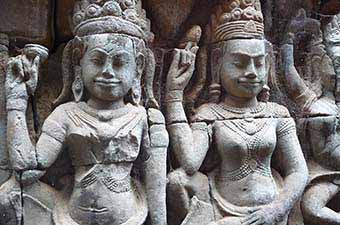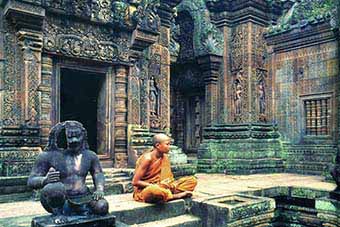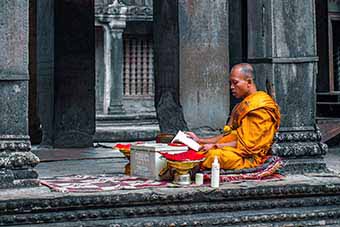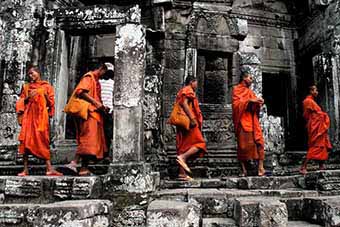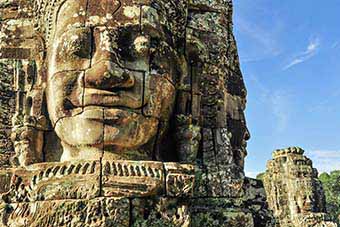"Here then are those temples which for so long seemed like visions... Here are the foundations, the plinths, the galleries, the extraordinary domes resembling multi-ringed tiaras" —Claude Farrere, L'illustration, 1931
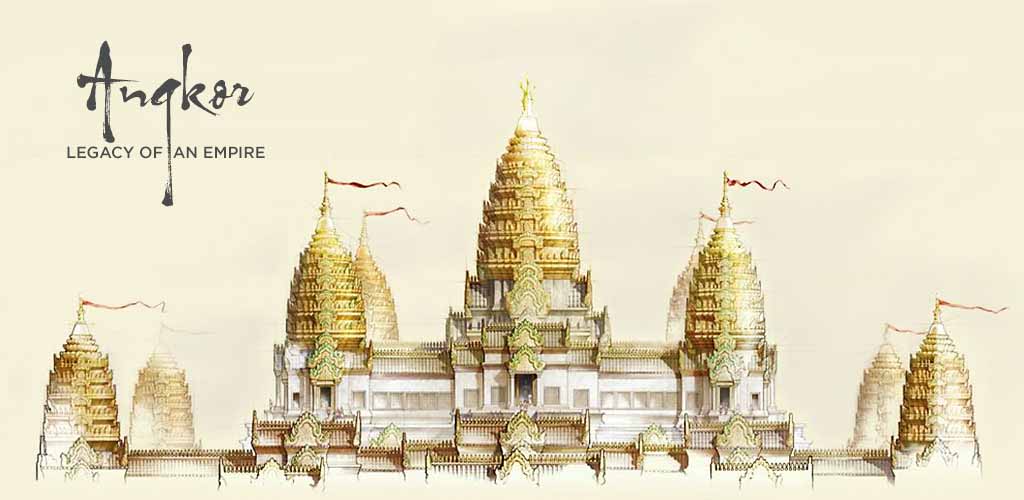
The "Prize of Southeast Asia" — the Temples of Angkor — are, surprising to most visitors, the greatest concentration of ruins ever constructed. Angkor what? Many people have heard of the main temple Angkor Wat, but Angkor, the temple complex of the same name, consists of over 70 discovered ruins spread over 200 square kilometers. Angkor Wat itself is a kilometer-wide and one of the most magnificent monuments ever constructed. There are astounding structures of equal impact all around — a density of ruins unparalleled anywhere else in the world, including the Nile Valley. A short one-hour hop from Vietnam or Thailand, Angkor provides an easy stop during any trip in the region and Siem Reap, the nearby base for exploring the temples, has become one of the region's most dynamic towns, including night markets and world-class dining and hotels. The temple complex is one of the most popular destinations in Asia, but take advantage of our over two decades arranging Angkor tours to explore an authentic side of Cambodia and Angkor away from the crowds.

Why Us?
Planning a visit to Angkor requires you to make choices—the area is simply too large, ancient sites too numerous, and a stay is never long enough to do the temples justice. Moreover, mass tourism, like any other popular destination, makes it a challenge to experience the solitude and romance of Angkor, while enjoying Angkor according to your interests, rather than working through a checklist. In addition, many delightful attractions, exciting activities, and fabulous dining have emerged over the last decade that should not be missed. There's a hundred ways to experience Angkor and Siem Reap, but after 25 years we know the best ones.
Angkor Highlights
— Siem Reap: once a sleepy base for exploring the temples is now one of Asia's most charming towns
— Hidden Angkor: it is possible to avoid the crowds. We will ensure you experience the magnificence and unique places in even at the most popular temples, in tranquility and away from the crowds.
— Angkor by helicopter: thrill to astonishing views from above the vastness of Angkor
— Architectural breadth: Angkor Wat is the most well known, but the Bayon, Banteay Srei, the South gate of Angkor Thom, and Ta Phrom are all magnificent and remarkably unique temples
— Hiking Kulen Mountain: ancient carvings under waterfalls and elephant sanctuary
— Sunrise cycling Ta Phrom: Two-wheeled adventure for everyone, away from the crowds
— Preak Toal: Enjoy Asia's largest bird sanctuary within the Tonlé Sap Biosphere Reserve
— Khmer heritage at the local silk farms, national and Korean museums.
— Roluos Group: most skip the petite yet well-preserved very first temples erected in the area, but shouldn't be missed.
— We've far more special places, activities, and encounters you should not miss while touring Angkor.

MAIN TEMPLES OF ANGKOR
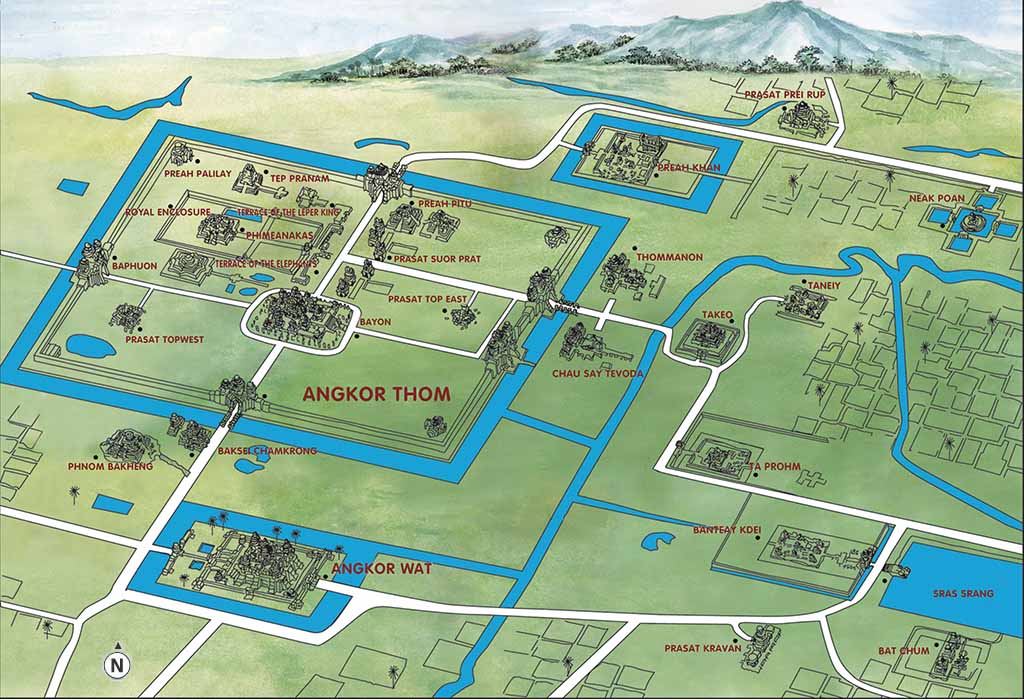
In the heart of Cambodia tangled threads of jungle meet the aspirations of mankind—the Temples of Angkor—an ineffable blend of solitude and spectacle that transports one to the outer edges of time and meaning. There's a haunting quality to these ancient ruins, a sense of both melancholy and magnificence that words can hardly capture. The air, thick with the scent of humid earth and millennia of history, seems to slow down here, as if hesitating before the intricate carvings and monumental structures. Angkor Wat, the most famous of them all, its grandeur monumental, yet there is an intimate whisper in its corridors that speaks to each visitor, a hushed echo that conjures the ephemeral nature of all human endeavor.
As you wander through the labyrinthine network of temples, from the gigantic mysteriously serene faces of Bayon to the exotic nature-enshrouded ruins of Ta Prohm, there's a compelling stillness and scale that invites introspection. It's as though each stone and every archway hold within them the condensed wisdom and follies of the ages, poised in a delicate balance between earthly existence and a more elusive, transcendent realm. In Angkor, one confronts not just the remarkable achievements of the Khmer Empire, but the timeless questions that have both bedeviled and elevated humanity across eons. Within the intertwining roots and solemn statues, amidst the play of light and shadow, you find a mirror held up to your own fleeting passage through the world—a quiet space in which to ponder the eternal, even as you stand amidst its ruins.
Angkor Wat
The temples of Angkor are one of the most under appreciated archaeological sites in the world, but a visit to the main and iconic Angkor Wat removes any doubt of how spectacular it is. A guidebook might inform you that Angkor Wat means "Temple City" in Khmer, that it was built in the early 12th century by King Suryavarman II, and that it's a spiritual home to both Hinduism and Buddhism. But what the guidebook won't tell you is how you feel minuscule yet strangely elated as approach and suddenly are confronted with the mammoth scale of the temple mountain, an effect confounded by traversing its half-mile labyrinthine of corridors, courtyards, and libraries, the galleries of which are all delicately carved with bas-reliefs in a visual lexicon of myth and history, featuring surreal stone narratives that range from the churning of the ocean of milk from Hindu epics, dancing celestial nymphs, to scenes of everyday Khmer life in what was the largest city in Asia during its peak with Angkor at its center.
Marvel as you stroll the temple that erecting of Angkor Wat required a staggering 5-10 million sandstone blocks weighing up to 1.5 tons each that were transported over 30 miles away from the sacred mountain of Phnom Kulen, then floated down the Siem Reap River by rafts. An enormous undertaking that was noted by inscriptions to require nearly 6,000 elephants and 300,000 workers laboring over 35 years.
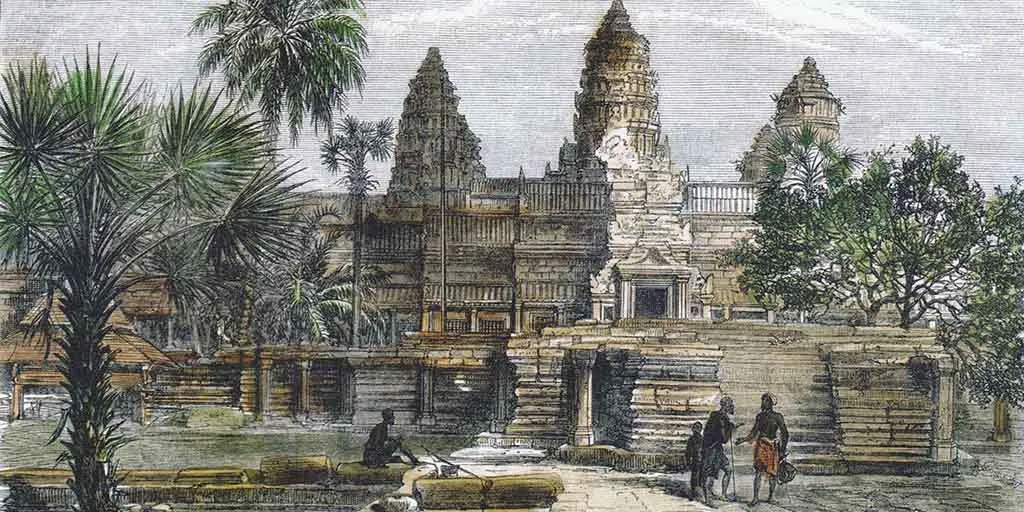
As you exit Angkor, you may feel neither the euphoria of having checked off a bucket-list place nor the fatigue that often accompanies such tourist pilgrimages. Rather, you will feel imbued with a quietude, a contemplative pause that only rare and magnificent places like Angkor Wat can inspire—a fleeting connection to the sublime enigma that is our shared human journey. Angkor can be a very busy place, but let us show you quieter places of the temple during its most tranquil moments.
Angkor Thom
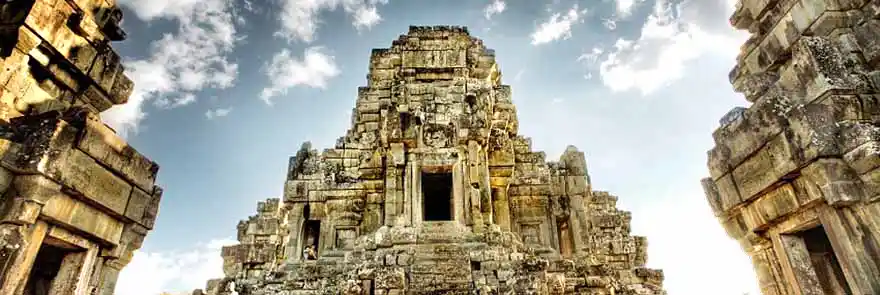
Angkor Thom is a city within a city, with dozens of striking and unique monuments, including the surreal Bayon (above), a favorite of most visitors. At the heart of Angkor Thom is the Bayon (above), the mesmerizing, if not mind-bending temple of Jayavarman VII's ego whose massive 4-headed stone faces smile down at you.
If Angkor Wat is classic and grand, the Bayon is wild and erratic. Who could've conjured this fantastic structure, and then—even more incredible—fashioned it from stone? Like Stonehenge or the Pyramids, the bizarre Bayon baffles with its design, its mysterious structure, its aura. The structure is simply amazing. What at first appears to be a random pile of masonry actually consists of massive stones shaped into fluid sculptures, without apparent use of cement or mortar. The Bayon was once even more elaborate, the central tower apparently covered in gold leaf. Zhou Daguan described it in the 13th century: "At the center of the Kingdom rises a Golden Tower flanked by more than twenty lesser towers and several hundred stone chambers. On the eastern side is a golden bridge guarded by two lions of gold, one on each side, with eight golden Buddhas spaced along the stone chambers." Oddly enough, Zhou Daguan failed to mention the massive heads on the Bayon towers. Read more about Angkor Thom The Splendors of Angkor Thom. by Michael Buckley
Ta Phrom
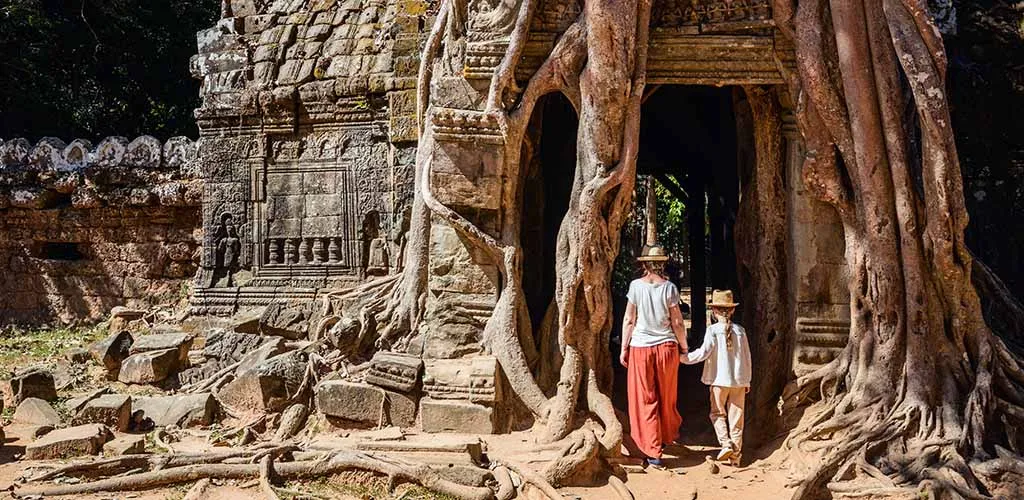
Certainly one of Angkor's most iconic sights. Left to the jungle, Ta Phrom over the centuries has been overrun by roots of trees and plants. The contrast has created an incredible setting of stone and plant. In many other ways, the ancient sanctuary is also unlike any other. Built in the late 12th century by the Khmer king Jayavarman VII, this temple was originally known as Rajavihara, or 'the royal monastery.' But the pages of time have weathered its stones, and now it's more commonly known as Ta Phrom, 'ancestor Brahma.' Imagine, a temple ensnared by the unyielding grasp of nature. Strangler figs and silk-cotton trees fuse with stones, their roots enveloping the ancient walls like the arms of a doting yet overbearing mother. As you wander through the labyrinthine corridors and courtyards, you'll encounter a surreal dance between creation and decay—a place where nature reclaims its territory, yet somehow magnifies the beauty of human endeavor.
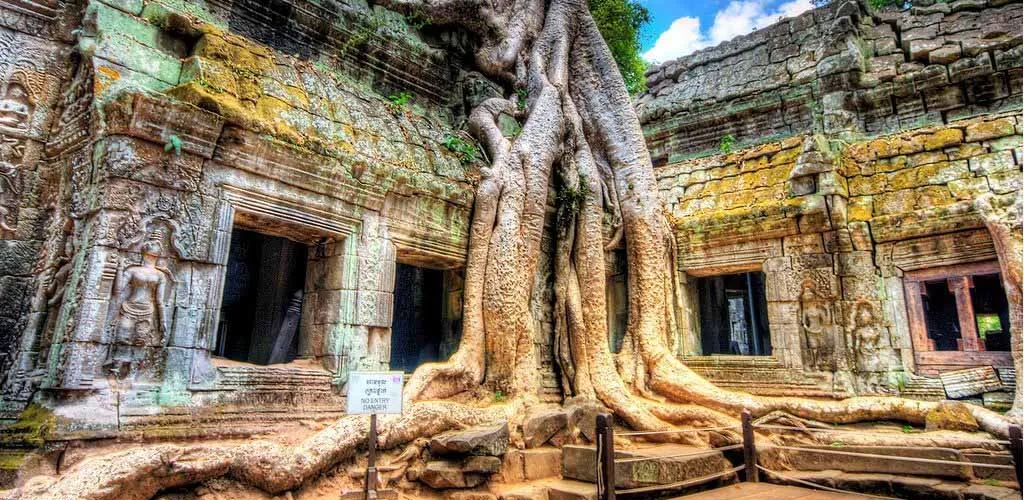
This is a temple frozen in a tender embrace with the jungle, left much as it was found by the Western archaeologists who stumbled upon it in the early 20th century. Unlike Angkor Wat or Bayon, the restorers decided to maintain Ta Prohm's romantically ruinated state, making it a poignant snapshot of impermanence, a still life capturing the inevitable convergence of man and nature. It's as if you're walking through an epic poem written in stone and foliage, each root and reliefs narrating a forgotten tale of devotion, aspiration, and perhaps, hubris. Ta Prohm is also famous for its intricate carvings and bas-reliefs that take you on a transcendental journey to ancient Hindu and Buddhist cosmology. However, nature's artistry competes for attention, interlacing itself with the divine countenances sculpted on the temple walls. Deities and demons find themselves framed by serpentine roots, an evocative symbolism that could stir even the most skeptical souls. And for my cinephiles out there—yes, Ta Prohm gained Hollywood fame as a backdrop in the film 'Tomb Raider.' But, let us assure you, this temple doesn't need CGI or cinematic flair to leave you spellbound. It's a real-life adventure, a place that lets your imagination roam as wildly as the jungle that envelops it. So, to those of you itching to step outside the boundaries of the ordinary. Whether you're a history buff, a spiritual seeker, or someone entranced by the ceaseless dance between creation and decay, Ta Prohm offers a soul-stirring experience that defies description. It's not just a visit; it's a pilgrimage to a world where man's greatest creations bow in humble submission to the grand designs of Mother Nature.
Banteay Srei
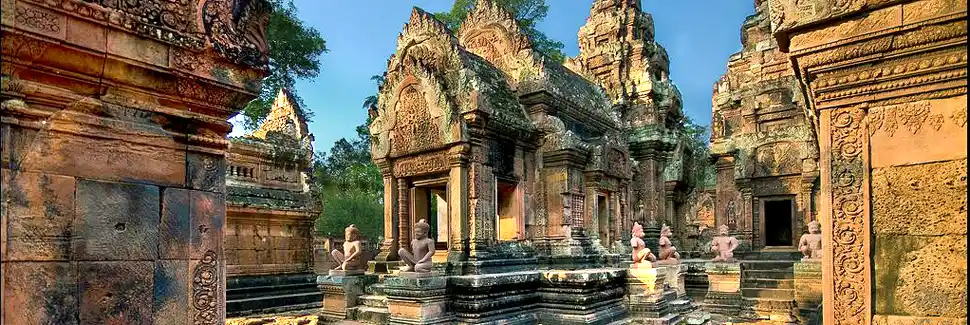
Angkor Wat typically steals the limelight of the great Cambodian temples. But allow us to gush about Banteay Srei, the ‘Citadel of the Women,’ a petite gem that is one of the world's greatest treasures. Nestled an hour outside of the main Angkor complex, Banteay Srei stands apart not just by geography, but also by its staggering intricacy and jaw-dropping artistry. Its petite scale and location reflecting it as one of the earliest temples erected in Angkor, Banteay Srei features the most intricate of bas reliefs carved in bright pink sandstone. Built in the 10th century, it predates its more famous neighbor Angkor Wat by a couple of hundred years and tells a story of its own. The name 'Banteay Srei' translates to 'Citadel of the Women,' and legend has it that the temple was so delicately carved, only the hands of a woman could achieve such finesse. While there's no definitive evidence to support this poetic notion, one thing is for sure—the craftsmanship here is second to none in the Angkor complex.
As you stroll through the temple, discover a labyrinth of divine carvings depicting scenes from Hindu epics like the Ramayana and Mahabharata, each etched in rose-pink sandstone that appears to glow like embers in the soft morning light. Now, imagine intricate lacework, but in stone—a three-dimensional tapestry frozen in rock. The figures of gods and goddesses, demigods, and mythical creatures are so exquisitely detailed that they practically leap out from the walls, whispering tales of ancient grandeur and devotion. You’d be forgiven for thinking you've stepped into a holy gallery curated by celestial artisans. Banteay Srei offers a unique moment to pause, a sanctuary that lures your senses into a symphony of beauty and wonder. The intimacy of the temple, combined with its artistic bravado, creates an atmosphere thick with mystique. It's like the jewel in Angkor's crown, small enough to miss but with a sparkle that can blind you with its magnificence. And while you're there, don’t forget to take a moment, sit on those ancient steps, and feel the centuries-old pulse of this awe-inspiring haven. Share the same seat that countless souls have rested upon, all captivated by this heavenly slice of human achievement. In a world often obsessed with size and grandeur, Banteay Srei proves that sometimes the most profound statements are whispered, not shouted. It's an awe-inspiring reminder that beauty often resides in the details, in the delicate strokes that might be easily overlooked but can never be forgotten once seen.


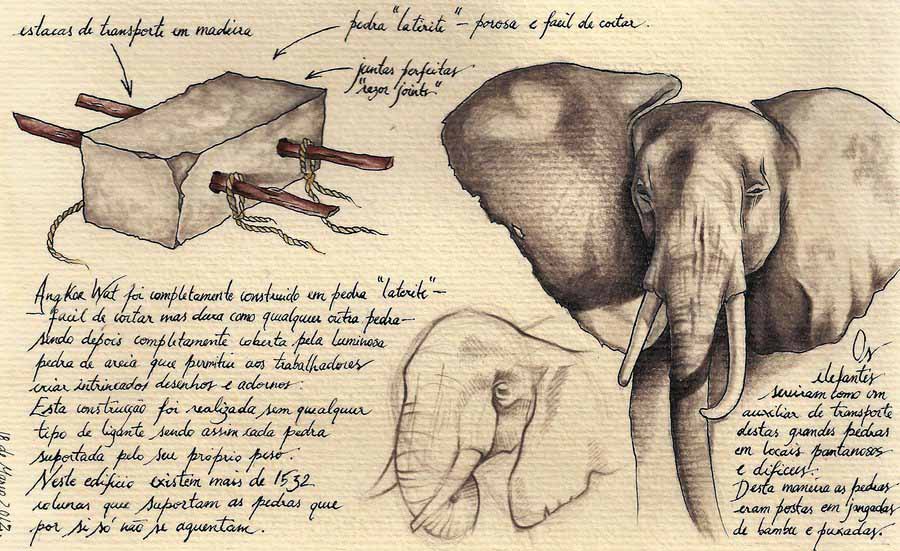
Private Villa in Angkor
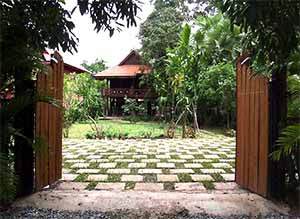 For a private moment within the temple complex, reserve a stylish, traditional wooden house overlooking the royal bathing pond of Sra Srang. Once used by the ancient Khmer kings and their concubines, this is a celebrated spot for sunrise and sunset. In a serene setting amid the rural village atmosphere of Angkor, this sala offers a range of original experiences from dining, cooking classes and cocktails and is the perfect private escape from the crowds around Angkor during the heat of the day. Unwind or indulge, it’s the perfect complement to the temples for special occasions.
For a private moment within the temple complex, reserve a stylish, traditional wooden house overlooking the royal bathing pond of Sra Srang. Once used by the ancient Khmer kings and their concubines, this is a celebrated spot for sunrise and sunset. In a serene setting amid the rural village atmosphere of Angkor, this sala offers a range of original experiences from dining, cooking classes and cocktails and is the perfect private escape from the crowds around Angkor during the heat of the day. Unwind or indulge, it’s the perfect complement to the temples for special occasions.
Options at the sala include:
—Enjoy a breakfast choice from three continents between.
—Khmer Cooking Class between 8am and 12 noon, which we begin with a visit to the local market. Maximum of six people.
—Lunch outdoors, Khmer and international.
—Yoga or meditation, by prior appointment, between 2-5 pm.
—Sunset Cocktails - with a signature Khmer cocktail, similar to the Singapore Sling but with a unique twist.
—Dinner of Khmer and international cuisine, between 7-10 pm.

Daytrips in and around ANGKOR
Beng Mealea & Koh Ker

Enjoy and early morning adventure, departing from Siem Reap to visit "the lost temple" of Beng Mealea. Beng Mealea, a titanic temple the size of Angkor Wat, was a slumbering giant lost for centuries in the encroaching forests of Cambodia and resembles a set from Tomb Raider. The temple is a mirror image of Angkor Wat, but totally consumed by the region's voracious flora. Constructed by Suryavarman II (1113-1150), the builder of Angkor Wat, the forest has grown wild here making hard to get a sense of where the monument ends and nature begins
Note: Although it is the most accessible of Angkor’s lost temples, to reach the best viewpoints, some climbing is necessary and in some areas are ladders to aid. After exploring the complex, enjoy a picnic lunch overlooking the ruins.
After Beng Mealea, visit nearby Koh Ker, a large temple mount. Abandoned to the forests of the north, Koh Ker, capital of the Angkorian empire from AD 928 to AD 944, is now within day-trip distance of Siem Reap. Most visitors start at Prasat Krahom where impressive stone carvings grace lintels, doorposts and slender window columns. The principal monument is Mayan-looking Prasat Thom, a 55m-wide, 40m-high sandstone-faced pyramid whose seven tiers offer spectacular views across the forest. Among the many other temples that are found around Koh Ker, Prasat Bram is the real highlight, a collection of brick towers, at least two of which have been completely smothered by voracious strangler figs; the probing roots having cut through the brickwork like liquid.
Kulen Hills Hiking and Elephant Sanctuary
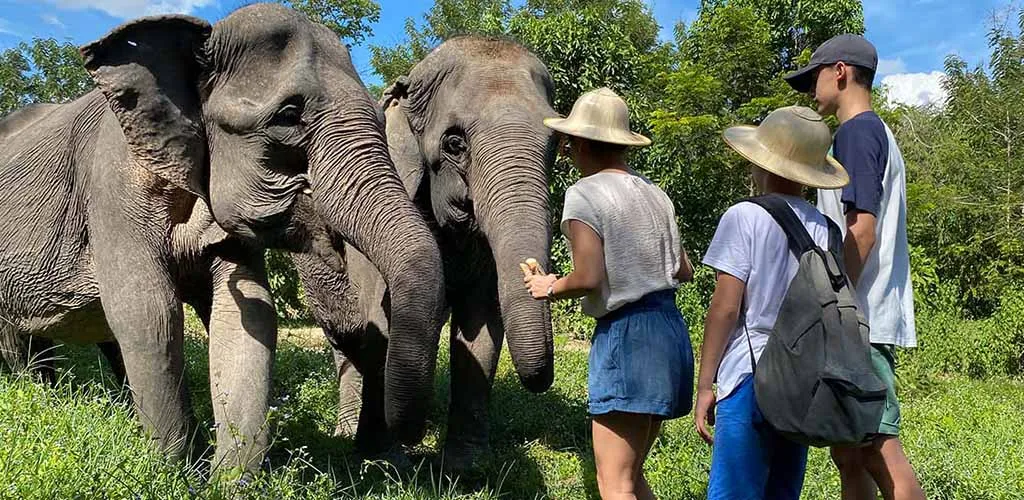
Under an hour away from Siem Reap at sacred Mount Kulen (where the stones for Angkor were quarried) lies the Kulen Elephant Sanctuary (The Kulen Elephant Forest), a new breed of elephant sanctuary where older elephants are sent after returning from giving rides in Angkor. The sanctuary, like many other in the region, now cares and offers encounters with the animals according to the highest ethical practices and seeks to foster learning about the threat to the animals in Asia. During your Angkor tour, we can organize a half-day visit to the sanctuary, learning about the elephants, care and the mission of the sanctuary.
Tonle Sap Lake

Travel by boat on vast Tonle Sap lake to Kompong Pluk (water levels permitting). Cruising down the narrow waterway into this medieval floating village, where the houses stand atop stilts as much as twenty feet above the water. The population of about 10,000 people, all of whom make a living from the fishing industry. Everything here lives on or above the water, including pigs, dogs, crocodiles and people, all jockeying for space in this unique floating community. Also exploration the surreal flooded forest here before continuing to the village of Chong Kneas. After reaching dry land, return to Siem Reap by road to freshen up before dinner.
Daytrip Notes: departing by 7:00 AM will place us at Beng Mealea and will have us there before any groups, but as with any other temples, the earlier the better. Picnic lunch today.

Helicopter to Preah Vihear
We can organize short flights over the temples (from 20 minutes to longer) and longer flights of one to three hours, including the stunning clifftop setting of Preah Vihear, landing to explore the temples by foot.
Angkor Photography
Our last photography series tour of Vietnam & Angkor concentrated on places providing exceptional photography opportunities, including the stoic capital, Hanoi, overnight on Halong Bay, hilltribes and mountain vistas of Sapa, and the emerald green vistas of the Mekong Delta. In Cambodia, the now bustling capital city of Phnom Penh was visited, and the tour culminated in shooting at what was the center of a great civilization, the grand temples of Angkor. View some of the the images taken by participants on the trip here: Vietnam & Angkor Images Gallery.
Beyond Angkor: For more touring and travel ideas in Cambodia, visit our Cambodia Tours page and our favorite capital city in Southeast Asia, Phnom Penh, an easy and fascinating one-day stopover en route to the temples.
Angkor Guest Escorts
Renowned Khmer historian Dr. Pich Keo, who has been interested in Khmer Arts and the history of Angkor since a young boy. In 1965 he attended the school of fine art in Phnom Penh until 1970. After graduation he was employed by the École Française d'Extreme Orient (EFEO) working for the Angkor conservation until the Khmer rough took over the area in 1975. In 1980, after the fall of the Khmer Rouge to the Vietnamese. In 1992 he became the Director of the National Museum in Phnom Penh and recently he has been promoted to be the Director of Department of Angkor Conservation working in cooperation with the UNESCO and the Ministry of fine art and culture.

Angkor Readings
We recommend reading the following articles and books to reference during your exploration of the temples:
Angkor, Why An Ancient Civilization Collapsed by National Geographic, July 2009. Scientists now believe Angkor utilized a vast and complex water system that collapsed due to drought. Read: Divining Angkor
Angkor, An Introduction to the Temples by Dawn Rooney. (1994, Passport). Revised edition 2011.
Angkor, Heart of an Asian Empire by Bruno Dagens (Thames and Hudson). Out of print.
Preparation for your visit
It is impossible for your guide to provide a comprehensive summary of the various temples, culture, and history of the Khmers during the short time they share with you. For those with desire of a deeper understanding, we will provide you with a reference book after arrival for your Angkor Tour. for those with desire of a deeper understanding, we recommend bringing Dawn Rooney's reference book -- the long time "bible" for the temples. We can also arrange a foreign expert, a top professor of Khmer archeology and architecture to spend a half day with you. Please inquire.
Angkor: Cambodia's Wondrous Khmer Temples (Sixth Edition) (Odyssey Illustrated Guides) Paperback – April 16, 2011 by Dawn Rooney

Images of Angkor
Ready to get started planning your Angkor Tour? Submit a contact form below, or call us:
San Francisco at (628) 256-0093
